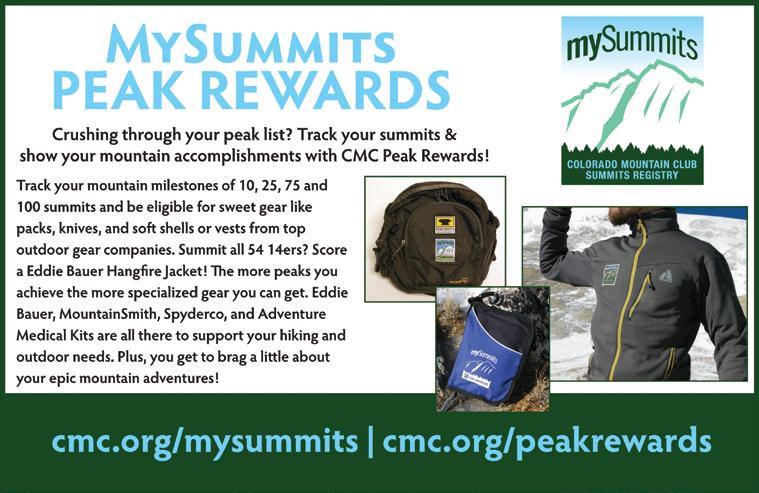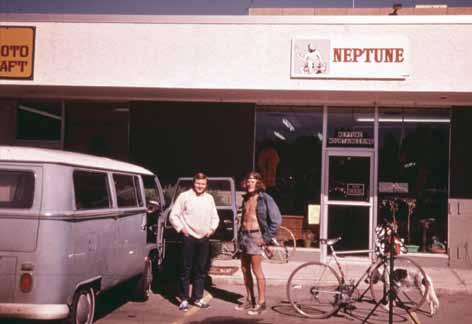
9 minute read
nePtune MOuntaineering
A Colorado Climbing Tradition and the End of an Era
An Interview with Gary Neptune, January 2014
By RICk CASEy
As anyone who climbs or backcountry skis in Boulder knows, Neptune Mountaineering is no ordinary mountaineering shop. And if you spend enough time there – or happen to attend one of the Thursday night shows that both inform and entertain – you are likely to meet the person who is responsible for the vision that created this venerable institution that is so treasured by so many: none other than Gary Neptune, who can still be seen walking around the shop, tending to business, barefoot, as is his wont.
Gary (on the left) at his first shop on 30th Street, 1973. Photo by Gary Neptune
This article is based on an interview I recently conducted with Gary, which I wanted to do for a couple of reasons. The first reason was the fact that the shop had been sold at the end of 2012 to a Texas corporation, backwoods Retail. That sale prompted me to wonder. What would this mean for the cultural aspects of this revered shop? Would the new owner recognize and value the social capital associated with its history? Secondly, would Gary’s strong support of the CMC over its history be recognized and preserved into the future? When I approached Gary with the idea, he was enthusiastic in wanting to do the interview and answer these questions.
First and foremost, it needs to be stated that Gary’s support of the CMC has been generous and unstinting over the years. The store has given a 10 percent discount to CMC members since it opened on April 1, 1973; in addition, CMC instructors and trip leaders received even greater discounts. Just imagine how large an amount that has been over 41 years! How many mountaineering shops have offered that level of community support? I cannot think of one.
It should also be noted that beyond the price discounts, the boulder CMC group has subleased its space for its clubroom from Neptune Mountaineering since 2000. A spacious area (the current location of the Yoga Loft) was rented for years at well below market rates. The current clubroom location, when a smaller space was renegotiated and remodeled, was created in 2010. This sublease arrangement has continued with the new ownership of the shop and has worked out well.
My first contact with Neptune Mountaineering was in 1981 when I moved to Colorado. I purchased some mountaineering sunglasses at the shop when it was on 30th Street. Gary had started this shop after working for Holubar, an early supplier of mountaineering equipment. The Holubar managers cultivated a culture of customer loyalty based on employees who shared their passion for the outdoors. Gary brought that passion and loyalty to Neptune Mountaineering.
My first question to Gary was if he had a real plan when he opened his shop. And he quickly replied, “Not really. I just desperately wanted to live close to mountains!” This tremendous zeal for climbing and the outdoors leaps out from the photographs of Gary’s early trips, such as when he and his climbing partner rode their motorcycles from Colorado to southern utah to climb Shiprock, which was little known at the time.
In the early years of the shop, when the climbing community was quite small, he focused on boot repair for the more steady income than what selling climbing gear brought in. The climbing community was very close knit, and another climbing shop was not seen as a competitive threat but
as a welcome addition to that community. There weren’t many climbers in those days, to be sure!
Rock climbing and mountaineering were still a fringe sport back in the 1970s, and it was possible to actually get to know most of the climbers in the area. back then, the CMC was the only place in boulder to take classes in outdoor sports, and Gary was certainly part of that. He led trips and taught in the schools, mostly with rock climbing, cross country skiing, and later high altitude mountaineering.
An important development that was happening as Neptune Mountaineering was growing was “clean climbing.” This began to take hold in the late 1970s, as the sport grew in popularity and technical equipment gradually started to make the sport safer and accessible to more people. “Clean climbing” refers to the type of equipment used to protect the leader. Here it meant not using pitons, which are basically metal spikes that were hammered into cracks in the rock. Pitons protect the lead climber and provide belay and rappel anchors. However, this practice becomes quite destructive to the rock over time, which had been recognized in other areas.
Though the modern clean climbing phenomenon in America originated in Yosemite, clean climbing techniques have been practiced for over 100 years in places such as Saxony, Germany. by the 1970s, however, when the sport was poised to expand rapidly, the invention of hex centrics by Yvon Chouinard and Tom Frost marked a revolution in popular climbing. The Yosemite climbing community quickly switched to this new, more environmentally sustainable form of protection, and the rest of the climbing community eventually followed. The transition was not instantaneous. Climbers were used to the security of pitons and had to learn to use and trust this new, more difficult method of protection. (The story of Roger briggs’ first ascent of the difficult death and Transfiguration route in the Flatirons is illustrative of this. Roger had intended to use pitons the day of his ascent of the route in 1972 but decided to see if hexentrics would work. They did, convincing Roger to start using them over pitons.)
Fortunately for climbing shops, this meant a new line of equipment to sell. As Gary recalled, however, this did not have a big impact for his shop at the time.Though it was still a small market, the innovation of clean climbing technology had huge implications. It improved the sustainability of the sport, ensuring that climbers could enjoy the sport in perpetuity without degrading the environment. “We loved hexes when they first appeared. They greatly improved protecting large cracks. I remember finding pieces of 2x4 wood in the Ruper crack when I first did it in September of 1971.”
Later, when camming devices were invented (known as “Friends” and “Aliens”), this would be another quantum leap in the technology, allowing climbers to climb more safely, and, of course, benefitting the mountaineering shops by selling more gear. Neptune Mountaineering was one of the first shops in Colorado to offer this kind of gear. When sport climbing, which uses bolts in the rock for protection, took off in the 1980s, this offered yet another line of equipment to sell. As the trends of climbing (and skiing) changed, Neptune Mountaineering changed with them and survived the years as other outdoor equipment shops in the town came and went. by 1983 Gary decided the shop needed more space and better access to customers. So he moved from 30th Street to the Table Mesa Shopping Center. This location was in the current location of the Southern Sun brewpub. It gave Neptune more space to display product, the opportunity to offer rentals on ski equipment and climbing shoes, and to add a service shop for skis. It was around this period too that Neptune began to present its “Thursday night shows”. These steadily grew into a venue where world famous mountaineers coming through boulder would make many memorable presentations. These had first been started by Gary as very informal affairs. It was kind of like, “This is how I spent my summer vacation,’” chuckled Gary, as he re-
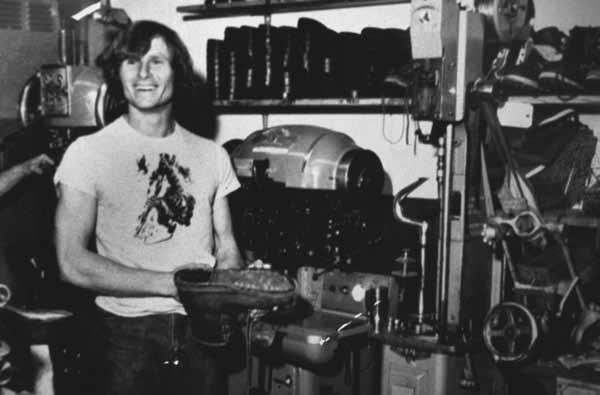
Gary working on a boot repair, 1973. Photo by Gary Neptune
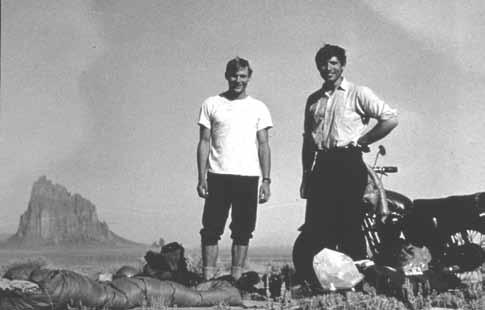
In 1993, the shop moved into the Table Mesa shopping center. Photo by Gary Neptune
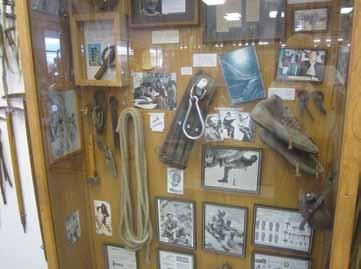
Part of the Neptune museum in glass cases. Photo by Gary Neptune
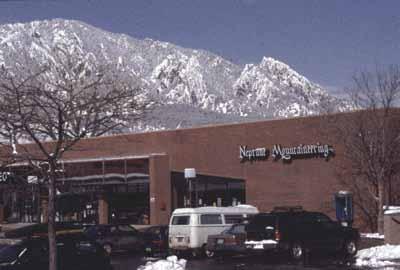
Standing, moveable displays of the Neptune museum. Photo by Gary Neptune
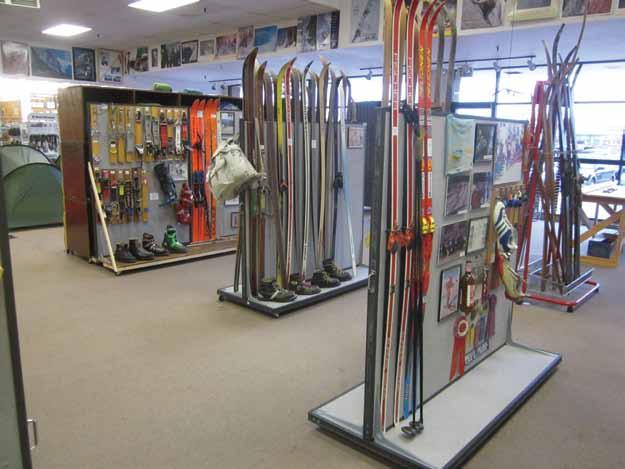
called one of his first shows being about his ascent of Mt. McKinley in the 1970s. They became so much more.
In 1993 the shop moved into its present location, anchoring the northern end of the Table Mesa shopping center.
I have many pleasant memories of these Thursday night shows over the years. For a long time attendees simply sat on the floor. You learned quickly to bring your own chair, usually a Crazy Creek chair or some variant that was easily carried in. The current arrangement, with dozens of folding chairs and a complete audio/visual system on a big screen, is quite luxurious by comparison.
Many famous names have presented at these gatherings, certainly more than I can recall. but Lynn Hill, Chris bonington, Layton Kor, Peter Habler, Ed Webster, Todd Skinner, Paul Piana, Marko Prezelj, Stefan Glowacz, Steph davis, and Jonny Copp come to mind. Even Edmund Hillary once came, so I hear, though I did not attend that show. The other less famous, but no less memorable, shows over the years have created an enduring legacy associated with Neptune Mountaineering and have made it a true center of the mountaineering culture in the American West. These inspiring talks have helped many pursue their own dreams of big trips, fantastic adventures, and personal development.
When you visit the shop you cannot help but notice the amazing amount of paraphernalia that covers the walls throughout the store. Much of it is climbing- related,
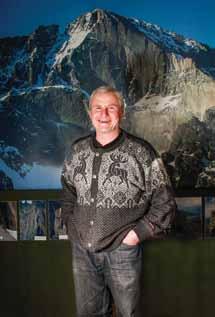
Gary Neptune in the foyer of Neptune Mountaineering. Photo by Janine Fugere and all of it is interesting and often quite humorous. Many are clearly from personal friends of Gary with an endearing note. Some are bittersweet as well. Some are pictures of climbers who perished in pursuing their love for these great but dangerous sports.
Such is the amount of material in the “Neptune museum” that after the sale of the shop to backwoods in 2012, there was a conscious effort to organize it better. Much of it now is in the auditorium area. Some of it is mounted in movable displays, allowing for quick rearrangement to create floor space for the Thursday night shows.
The transfer of ownership to an outof-state corporation came as shock to the community. Neptune Mountaineering had become an institution to the local climbing and backcountry skiing culture. However, Gary reassures that the new owners recognize the cultural value of the shop and is part of the reason he decided to sell to them. backwoods Retail is a family-owned business and currently run by the daughter of the founder, who started his first store just one month earlier then Neptune’s. Their support of the culture around the shop was publicly acknowledged by the new owner from the start:
“Neptune is a very big part of the boulder community. We want to add to its prosperity.…” said new owner Jennifer Mull, CEO of backwoods Retail, in an article which appeared in the boulder daily Camera on January 7, 2013.
The CMC wishes every success to the new owner of Neptune Mountaineering and looks forward to continuing to work with this wonderful institution that has meant so much to the Club and the boulder outdoor community over the years. △
